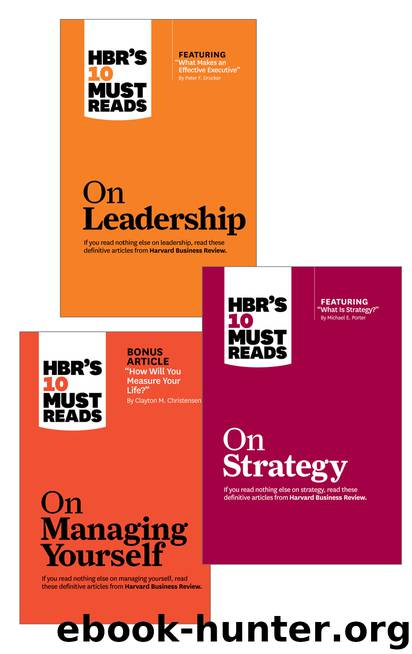The HBR's 10 Must Reads Leader's Collection (3 Books) by Harvard Business Review

Author:Harvard Business Review [Harvard Business Review]
Language: eng
Format: epub
Publisher: Harvard Business Review Press
Published: 2011-02-06T16:00:00+00:00
Jessica Spungin found herself caught in this trap when she was promoted to associate principal in McKinsey’s London office. As an AP, a consultant is expected to take on more responsibilities of the partnership group, juggle multiple projects, serve as a team leader, and play an active role in office life. Spungin dove in to all these tasks headfirst. While she was handling two major client projects, she was asked to jointly lead recruitment for U.K. universities and business schools, participate in an internal research initiative, serve as a senior coach for six business analysts, run an office party for 750 people, get involved in internal training, and help out on a new project for a health care company.
In her first round of feedback from the three project teams she oversaw, she was rated second from the bottom among her peers. Spungin realized that her desire to be indispensable sprang from a lack of confidence. “I never said no to people in case they thought I couldn’t cope. I never said no to a client who wanted me to be present at a meeting,” she told us. “I did what I thought was expected—regardless of what I was good at, what was important, or what I could physically do.”
The first step in Spungin’s transformation from a busy to an effective manager was to develop a vision of what she really wanted to achieve at McKinsey: to be named a partner. In developing a clear mental picture of herself in that role, she traded in her habit of thinking in short time spans of three to six months to thinking in strategic time spans of one to five years.
This longer-term planning allowed Spungin to develop a set of long-term goals and priorities. Soon, she took control of her own development. For example, it became clear to Spungin that corporate banking—which her colleagues believed to be her area of expertise based on her past experience—did not hold any real interest for her, even though she had accepted one banking project after another. Instead, she decided to shift her focus to the organizational practice, something she really enjoyed. (McKinsey, like many companies, allows its consultants significant flexibility in terms of choosing assignments, but most managers do not avail themselves of this opportunity.) By claiming a personal agenda and integrating short-, medium-, and long-term responsibilities into her broader master plan, Spungin felt much more motivated and excited about her work than she had when she was merely responding to everyday demands.
Finally, Spungin took charge of her time. She realized that trying to be accessible to everyone made her inaccessible to those who really needed her. She began prioritizing the time she spent with clients and team members. With her personal assistant’s help, she streamlined her work. Previously, her assistant would schedule meetings in an ad hoc manner. Now, Spungin drove the calendar, so she could make the calls about which meetings she needed to attend. She began to recognize patterns of work intensity according
Download
This site does not store any files on its server. We only index and link to content provided by other sites. Please contact the content providers to delete copyright contents if any and email us, we'll remove relevant links or contents immediately.
Bad Blood by John Carreyrou(5761)
Principles: Life and Work by Ray Dalio(5315)
Rich Dad Poor Dad by Robert T. Kiyosaki(5140)
Management Strategies for the Cloud Revolution: How Cloud Computing Is Transforming Business and Why You Can't Afford to Be Left Behind by Charles Babcock(4127)
The Confidence Code by Katty Kay(3561)
Thinking in Bets by Annie Duke(3528)
American Kingpin by Nick Bilton(2966)
Playing to Win_ How Strategy Really Works by A.G. Lafley & Roger L. Martin(2919)
Delivering Happiness by Tony Hsieh(2918)
Project Animal Farm: An Accidental Journey into the Secret World of Farming and the Truth About Our Food by Sonia Faruqi(2655)
Brotopia by Emily Chang(2588)
I Live in the Future & Here's How It Works by Nick Bilton(2520)
Mastering Bitcoin: Programming the Open Blockchain by Andreas M. Antonopoulos(2506)
The Content Trap by Bharat Anand(2488)
The Power of Habit by Charles Duhigg(2483)
The Marketing Plan Handbook: Develop Big-Picture Marketing Plans for Pennies on the Dollar by Robert W. Bly(2408)
The Tyranny of Metrics by Jerry Z. Muller(2399)
Building a StoryBrand by Donald Miller(2358)
Applied Empathy by Michael Ventura(2324)
